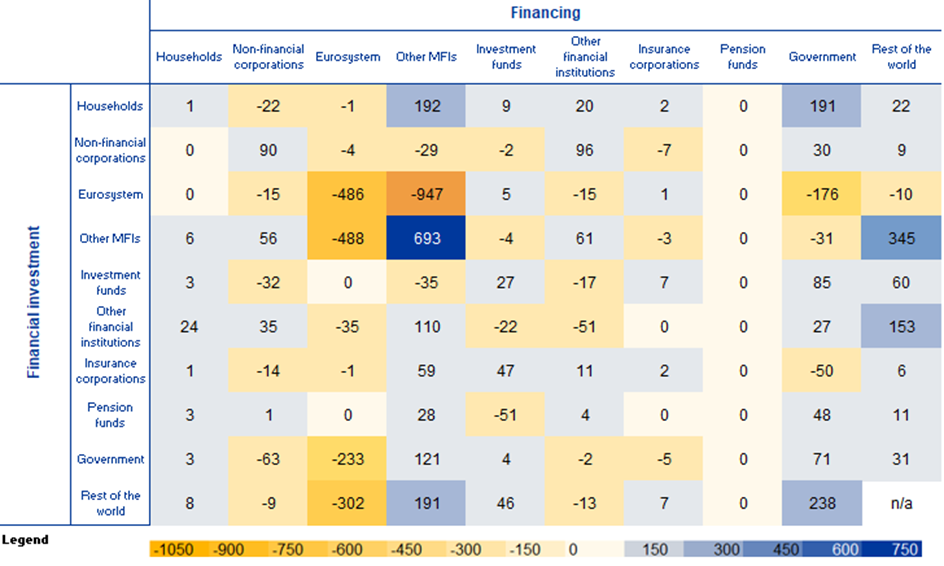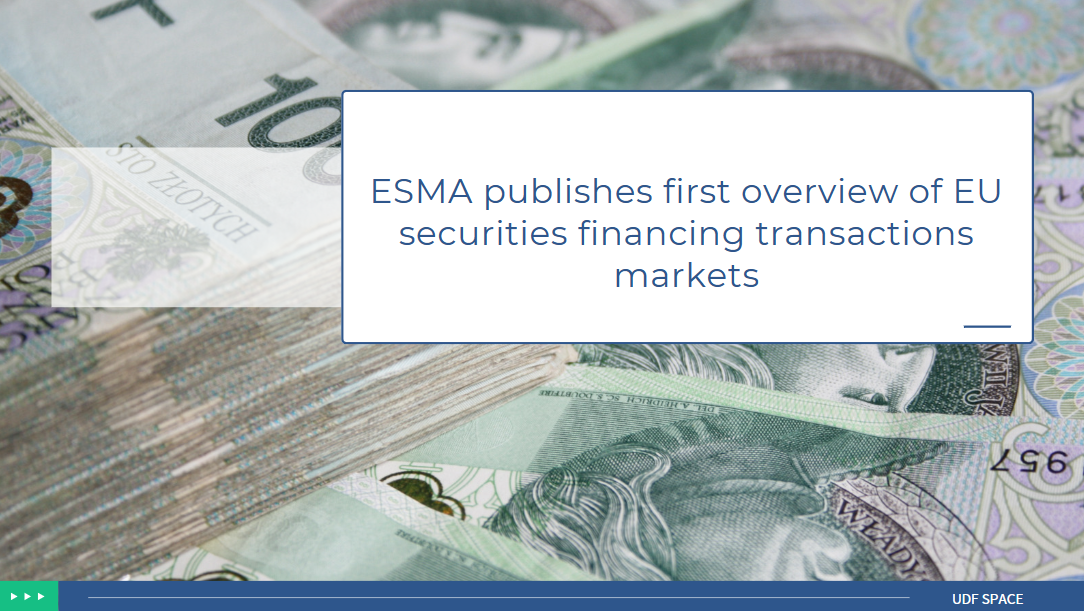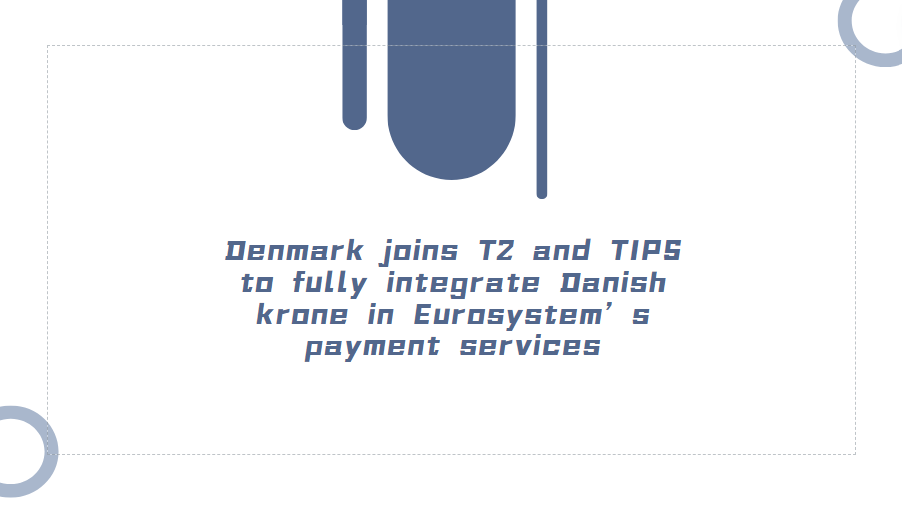Euro area economic and financial developments by institutional sector: fourth quarter of 2023
♦As of April 2024, ECB quarterly financial accounts provide new details on household holdings of investment fund shares/units broken down by underlying asset and counterpart sector. Notably, household exposure to rest of world assets is primarily through indirect holdings via investment fund shares
♦Euro area net saving increased to €833 billion in four quarters to fourth quarter of 2023, compared with €751 billion one quarter earlier
♦Household debt-to-income ratio decreased to 87.0% in fourth quarter of 2023 from 92.8% one year earlier
Non-financial corporations' debt-to-GDP ratio (consolidated measure) decreased to 67.1% in fourth quarter of 2023 from 71.6% one year earlier
New details on household assets
The ECB is from now on releasing more detailed data on household holdings of investment fund shares/units broken down by underlying asset and by counterpart sector, thereby providing further insights into households‘ indirect exposures.[1] Investment funds allow investors to gain exposure to a large number and variety of assets without buying them directly. Investment fund holdings amount to about one tenth of the total financial assets held by euro area households and are the fourth largest asset class after deposits, unlisted shares (for example, ownership in private businesses), and insurance and pension savings.
These new experimental data on households’ indirect exposures can be used to more accurately analyse the financial balance sheet of households and their exposure to different asset classes and counterpart sectors. The methodology and calculations have been prepared in close collaboration with euro area national central banks. The data are derived from several datasets available at the ECB: securities holding statistics by sector, investment fund statistics, and financial accounts data.
Households prefer indirect over direct exposures especially for assets issued by the rest of the world (i.e. where the issuers/debtors do not reside in the euro area), with the share of rest of the world in total assets increasing from 2% before the look-through to 9% afterwards (see Chart 1, which shows selected financial assets directly held by households vis-à-vis counterpart sectors in 2023 Q4, and the resulting breakdown by counterpart sectors after looking-through investment funds). Considering the financial instrument breakdown, the look-through leads to higher estimates especially for the households’ exposures to listed shares (from 5% to 9% of households’ assets) and debt securities (from 3% to 7%). For more details see the note on looking-through households’ investment in investment fund shares in the quarterly financial accounts.
Chart 1
Households’ financial assets by counterpart sector; selected financial instruments*

Source: ECB.
Notes: Discrepancies between totals and their components may arise from rounding.
This chart refers to financial instruments for which the counterpart sector breakdown is available: deposits, loans, debt securities, listed shares and investment fund shares/units. In addition, the counterpart sector breakdown for insurance, pension and standardised guarantee schemes (F.6) is an estimate. (See the methodological note on the ECB’s website: Extension of the who-to-whom presentation to insurance and pension assets).
Total euro area economy
Euro area net saving increased to €833 billion (7.3% of euro area net disposable income) in 2023 compared with €751 billion in the four-quarter period ending in the third quarter of 2023. Euro area net non-financial investment increased to €605 billion (5.3% of net disposable income), mainly due to increased net investment by non-financial corporations and government, while net investment of households was broadly unchanged (see Chart 2).
Euro area net lending to the rest of the world increased to €281 billion (from €200 billion in the previous quarter) reflecting net saving increasing more than non-financial investment. Net lending of households grew to €457 billion (4.0% of net disposable income) from €393 billion. Net lending of non-financial corporations decreased to €220 billion (1.9% of net disposable income) from €236 billion, and that of financial corporations decreased to €120 billion (1.0% of net disposable income) from €125 billion. Net borrowing by general government decreased, contributing thus less negatively (-€516 billion or ‑4.5% of net disposable income, after -€554 billion) to euro area net lending.
Chart 2
Euro area saving, investment and net lending to the rest of the world
(EUR billions, four-quarter sums)

* Net saving minus net capital transfers to the rest of the world (equals change in net worth due to transactions).
Financial transactions can be presented with a counterpart sector breakdown for deposits, loans, debt securities, listed shares and investment fund shares (see Table 1). In 2023 the largest aggregated transactions in these financial instruments were interbank operations as other MFIs[2] redeemed liabilities with the Eurosystem (-€947 billion), decreased deposits with the Eurosystem (-€488 billion) and increased deposits and other assets with other MFIs (€693 billion). Financial investment of households involved to a large extent transactions vis-à-vis other MFIs (€192 billion), mostly in the form of deposits, as well as the financing of government through purchases of debt securities (€187 billion). Non-financial corporations’ largest financing component (€90 billion) was from within the NFC sector, mostly in the form of loans and listed shares, while financing from other MFIs amounted to €56 billion. The largest financial transactions vis-à-vis the rest of the world were other MFIs’ financial investments (€345 billion).
Table 1
Selected financial transactions* between sectors and with the rest of the world
(EUR billions, four-quarter sums, 2023)

Source: ECB.
* Financial instruments for which the counterpart sector breakdown is available: deposits, loans, debt securities, listed shares and investment fund shares/units.
Households
Household financial investment increased at a broadly unchanged annual rate of 2.1% in the fourth quarter of 2023. Among its components, currency and deposits (0.9% after 0.5%) and debt securities (61.6% after 59.8%) grew at higher rates. This acceleration was mostly offset by slower growth of investments in shares and other equity (0.2% after 1.0%) and life insurance (-0.4% after 0.2%), while pension schemes grew at an unchanged rate (2.6%).
Households increased investment in debt securities was again driven by net purchases of debt securities issued by general government, MFIs and other financial institutions. Households were overall net sellers of listed shares, due to net sales of listed shares of non-financial corporations, while they purchased listed shares of all other sectors and the rest of the world (i.e. shares issued by non-euro area residents), (see Table 2 below and Table 2.2. in the Annex).
The household debt-to-income ratio[3] decreased to 87.0% in the fourth quarter of 2023 from 92.8% in the fourth quarter of 2022. The household debt-to-GDP ratio also decreased, to 53.6% in the fourth quarter of 2023 from 56.7% in the fourth quarter of 2022 (see Chart 3).





















































First, please LoginComment After ~